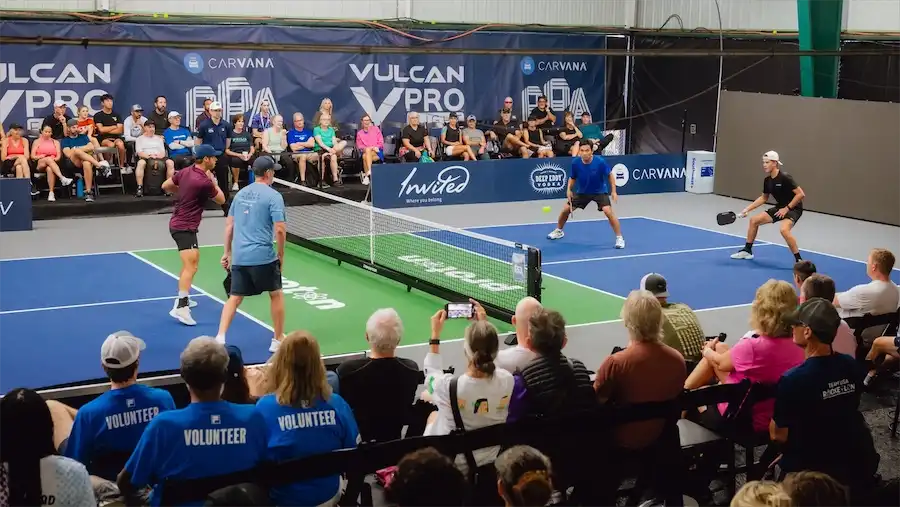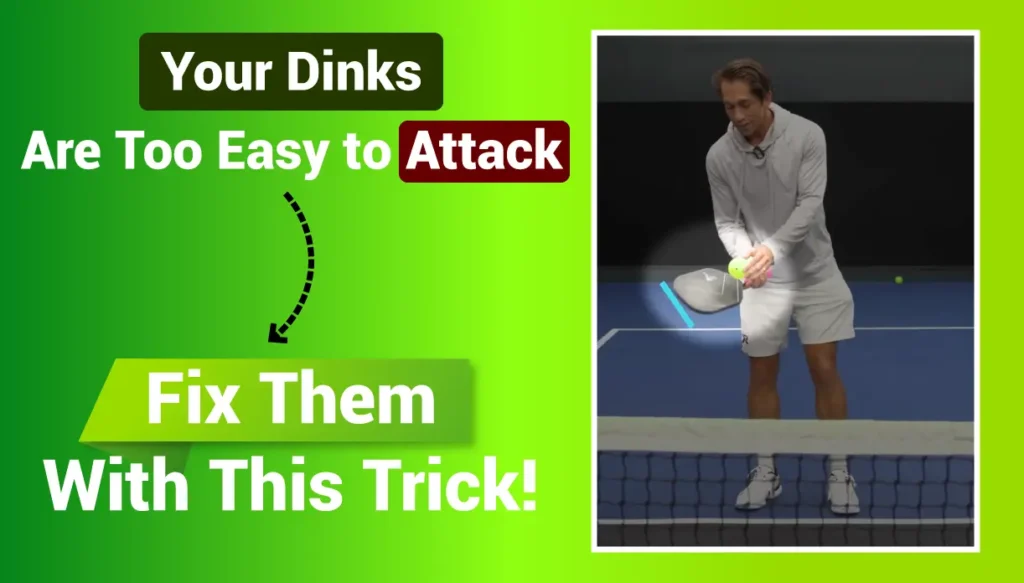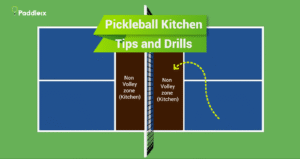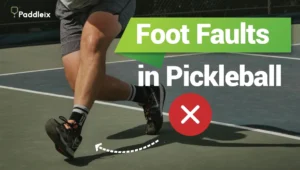I used to think dinking was just a filler shot… until I kept getting beat by players who barely moved from the kitchen line. That’s when it clicked — dinks are the secret sauce.
Once I started practicing the right drills, my confidence at the net soared. I began controlling rallies, forcing pop-ups, and winning more points without overhitting.
In this post, I’m sharing the pickleball dinking drills that changed my game — simple, repeatable, and seriously effective.
Let’s get to work!
My Top 6 Pickleball Dink Drills

Drill 1: Openers – Master the Serve and Return
It might surprise you, but most players never drill their serve or return. And yet, every single point starts with these two shots.
How it works:
- One player serves. One returns. Repeat.
- Focus on depth and targeting.
- Returner should run to the NVZ after hitting their return, just like in a real match.
Why it matters:
- Deep serves keep opponents back, preventing quick net access.
- Deep returns give you time to move forward and prepare for the third shot.
- Adding movement simulates real point dynamics.
🧠 Pro Tip: Pick a specific target (e.g., deep middle, deep backhand) and track your consistency over 10 reps. Make it competitive!
Drill 2: Charmin Drill – Softening Your Third Shot Drop
This one gets its name from—you guessed it—toilet paper softness. You want that third shot drop to land like a feather.
How it works:
- One player stays at the baseline, the other at the NVZ.
- Baseline player practices third shot drops repeatedly.
- Vary angles: straight ahead and crosscourt.
Why it matters:
- The third shot drop is often the most mishit shot in pickleball.
- Practicing under different angles prepares you for game-day chaos.
- The soft touch forces your opponent to hit up, giving you control.
📌 Make it game-like: Alternate who’s at the baseline, and turn it into a game—if a drop lands in the kitchen and forces a lift, it’s a point.
Drill 3: Space Invaders – Resetting From Midcourt
No-man’s-land—aka midcourt—isn’t where you want to be. But it’s where you often find yourself. The Space Invaders drill helps you reset and move up safely.
How it works:
- One player starts in midcourt, the other at the NVZ.
- Midcourt player must hit two clean resets in a row before advancing.
- If resets are weak or poppy, they stay back.
Why it matters:
- Resets teach you touch under pressure.
- Forces good decision-making before charging the kitchen.
- Prepares you for real transitions—after a lob, a fast volley, or a bad drop.
🎯 Add scoring: 1 point per successful “invasion.” First to 7 wins.
Drill 4: Setups – Crosscourt Dinking With a Purpose
Dinking isn’t the goal—it’s the setup. This drill helps you create attack opportunities, not just wait for them.
How it works:
- Two players dink crosscourt (forehand or backhand).
- The goal? Move your opponent with placement—not power.
- Think: inside foot, outside foot, close to sideline, tight to the net.
Why it matters:
- Builds awareness of how to disrupt balance.
- Encourages shot variation and movement, not robotic repetition.
- Sets the tone for your transition to offense.
⚡ Bonus strategy: Once your opponent’s balance breaks, go for a speed-up or angle dink. Turn defense into offense.
Drill 5: Tight Spaces – Up-the-Line Dinking & Fast Hands
This one’s spicy. Dinking straight ahead is harder than crosscourt—and when done well, it’s a great way to create fast hand battles.
How it works:
- You and a partner dink straight ahead—no crosscourt allowed.
- Play in “tight spaces”: same side of the court, narrow angles.
- Everything’s fair game: lobs, speed-ups, and volleys.
Why it matters:
- Forces precision—there’s less court to work with.
- Improves touch and feel due to smaller margin for error.
- Creates fast transitions to hand battles and counters.
🥊 Game mode: Play to 7. All shots legal. Get ready for fireworks.
Drill 6: Lightning – Fast Hands, Quick Reflexes
Hands battles at the kitchen line are what separate casual players from competitive ones. This drill is all about hand speed and down volleys.
How it works:
- Both players at the NVZ line (or even inside it).
- Rallies start with soft volleys, but each player is trying to get the ball down.
- Hit at about 70%—not max effort—but with aggressive intent.
Why it matters:
- Sharpens reflexes and paddle awareness.
- Builds comfort in chaotic moments.
- Trains you to end points by getting the ball down, not just volleying forever.
⚙️ Advanced variation: One player feeds only “down” shots; the other tries to reset upward, then flip the script and counterattack.
Bonus Drill: Skinny Singles

Once you’ve done all the drills, how do you apply them in a match-like scenario without four players? Enter Skinny Singles.
How it works:
- Play one-on-one using only one half of the court (crosscourt or straight-on).
- Alternate sides each game or every few points.
- Serves, returns, dinks, drops—all apply.
Why it matters:
- Combines everything: precision, placement, stamina, and strategy.
- Forces you to use smart shot selection and court awareness.
- Perfect for solo sessions with one practice partner.
💡 Pro Tip: Want to track improvement? Record yourself once a month playing Skinny Singles—you’ll notice huge gains in consistency and confidence.
How to Structure These Drills Into a Weekly Routine
To get the most out of these six drills, don’t try to do them all in one day. Instead, create a smart rotation:
| Day | Focus | Drills |
|---|---|---|
| Monday | Serve + Return | Openers (20 mins), Skinny Singles (15 mins) |
| Tuesday | Third Shot Drops | Charmin (20 mins), Setup Dinking (15 mins) |
| Thursday | Resets + Movement | Space Invaders (20 mins), Tight Spaces (15 mins) |
| Saturday | Game Readiness | Lightning (15 mins), Full Games or Skinny Singles |
Short, focused sessions beat long, sloppy ones. And remember: quality > quantity.
Taking Your Dinking to the Next Level
Once you’re feeling solid with the basics, you can start adding some advanced techniques to really frustrate your opponents.
1. Adding Spin to Your Dinks:
Whether it’s topspin or slice, adding spin to your dinks makes them harder to predict and even harder to return. Try brushing up on the ball to add topspin or slicing underneath it for backspin.
Both will make your dinks drop quicker and stay low.
2. Deception with Dinking:
One of my favorite tricks is faking out my opponent by changing paddle angles at the last second. It keeps them guessing and opens up opportunities for me to attack when they’re caught off guard.
3. Using Dinks to Set Up Attacks:
Remember, dinking is all about strategy. Keep your opponent locked in a dink battle, and when they pop the ball up, you’re ready to put it away with a strong volley or smash.
Common Dinking Mistakes (and How to Avoid Them)
Here’s the thing—everyone makes mistakes, especially when they’re just starting out with dinking. I’ve been there, so here are a few common pitfalls and how you can avoid them:
- Hitting the Ball Too Hard: Dinking isn’t about power. If you’re hitting the ball too hard, you’re making it easier for your opponent to attack. Focus on soft, controlled shots.
- Inconsistent Footwork: If you’re off-balance, your dinks are going to be inconsistent. Keep your footwork light and stay ready to adjust quickly.
- Poor Paddle Angle: Keep the paddle angle consistent and make sure it’s slightly open to ensure the ball stays low.
Drilling with a Purpose
When it comes to drills, it’s important to practice with a purpose. Set goals for your practice sessions, whether it’s hitting more accurate dinks, improving your footwork, or controlling the pace of rallies.
By setting specific targets, you’ll see improvement much faster.
Final Thought: The Drills Are the Shortcut
You don’t have to play 100 games to get better at dinking. If you want to accelerate improvement, these six drills are your secret weapon.
They cover:
- Touch
- Footwork
- Timing
- Shot selection
- Mental toughness
- Paddle speed
And they’re actually fun to do, especially when you add scoring or live-ball elements.
So the next time you walk onto the court, don’t just play—train. With purpose. With precision. And with just a bit of pressure to simulate the real deal.
Because remember, in pickleball—you don’t win with dinks, you win with the right dinks.
(FAQ) About Pickleball Dinking Drills
What is dinking, and why is it important?
Dinking is a soft shot near the net that keeps the ball low. It helps control the pace and forces your opponent to hit up, making it easier for you to win rallies.
How can I improve my dinking consistency?
Practice drills regularly, focus on control, and work on your footwork to stay balanced.
How do I practice dinking alone?
Use a wall or backboard to practice soft dinks, aiming for low and controlled shots.
How do I add spin to my dinks?
Brush up for topspin and slice under the ball for backspin. Spin makes your dinks harder to return.
What’s the difference between cross-court and down-the-line dinks?
Cross-court dinks go diagonally, while down-the-line dinks go straight along the sideline.
When should I switch from defensive to offensive dinks?
Attack when your opponent’s dink is high enough to add speed without risking a return.
How do I avoid hitting my dinks too hard?
Use a soft, controlled paddle motion and focus on keeping the ball low over the net.
What should I do if my opponent keeps smashing my dinks?
Keep the ball lower, aim for their weaker side, or add spin to make your dinks harder to attack.
What’s the best drill for footwork while dinking?
The “Dink-and-Move” drill, which involves moving along the kitchen line while dinking.
How often should I practice dinking drills?
Practice several times a week for 10-15 minutes to build consistency and control.



